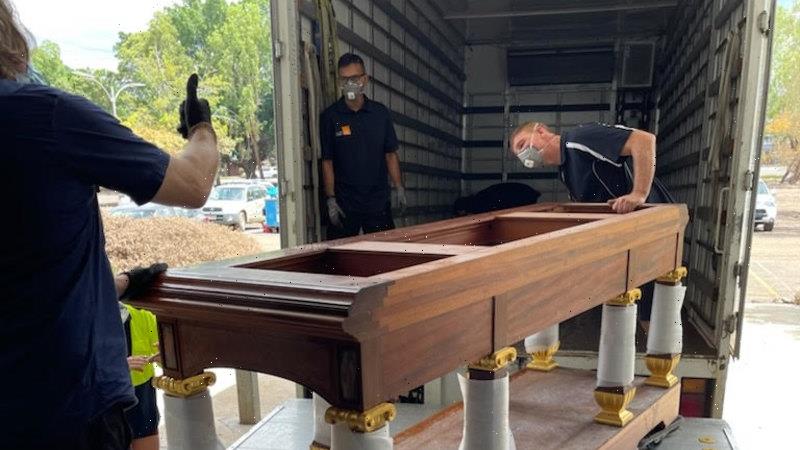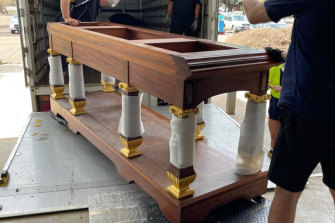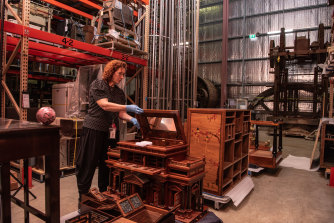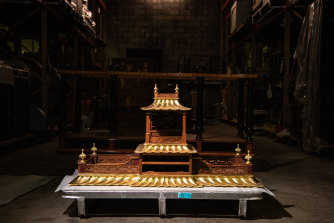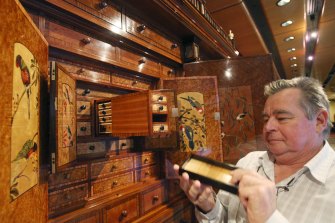The Hannah Cabinet, the most prized object among 1400 flood-damaged artworks from the Lismore Regional Gallery, seems to have survived the region’s worst flood in living memory.
Conservators are hopeful the last major public work by master craftsman Greg Hannah acquired in 2017 for $1 million can be salvaged, but it may be months if not years before the cabinet can be returned to public exhibition.
The Hannah Cabinet being removed from the Lismore Regional Gallery. Credit:Lismore Regional Gallery
Lismore Regional Gallery director Ashleigh Ralph said an initial report indicated that she should expect excellent results.
It’s been a worrying wait for Geoff Hannah who has begun the cleanup of his workshop and home. Hannah’s long-time associate Greg Peters is caretaking the precious cabinet piece, now dismantled and sitting in a temperature-controlled steel container in Canberra.
“The outlook is positive with some panel and drawer faces being unaffected,” Mr Peters said. “However the restoration will be a long process, with over a hundred marquetry and inlaid surfaces to restore.”
Lismore Regional Gallery was entirely inundated by the catastrophic flood that impacted the Northern Rivers region on February 28.
Artworks in its permanent collection and current exhibitions were impacted, Ms Ralph said. She remains optimistic that most artworks can be saved and enjoyed for many generations to come. A fund has been set up to help the gallery recover.
Bronwyn Dunn tends to the sister cabinets of master craftsman Geoff Hannah now in her care.Credit:Flavio Brancaleone
Staff had worked tirelessly to carefully remove damaged artworks from the gallery for conservation and insurance assessment, with assistance from specialist art handlers and conservators, Create NSW and Museum Galleries of NSW.
Created from 34 different types of solid timbers and veneers, four kinds of rare shells and 17 varieties of precious and semi-precious stones, the Hannah Cabinet is the gallery’s most valuable exhibit and renowned the world over.
It was discovered in pieces, the middle section containing drawers and secret compartments resting on its back, Mr Hannah said. By luck, it seems the ornate front face did not appear to have direct water contact.
Many of its moving parts and chambers, however, are swollen and remain stuck tight. Water has dissolved the glue that adheres to the veneers, and the inlays have come loose.
In its temperature-controlled hold, temperatures inside have been slowly brought down to near-freezing point to retard mould growth and assist the drying process.
Three other cabinets made by Hannah, have been delicately transported from the maker’s Lismore workshop to Powerhouse’s Museum Discovery Centre at Castle Hill.
Furniture by Greg Hannah at the Museum Discovery Centre for conservation after the floods. Credit:Flavio Brancaleone
The Jubilee, Chinoiserie and Wenge cabinets arrived in separate pieces, covered in mud and silt with mould developing, its curator Bronwyn Dunn said.
A cloudy bloom is visible in some areas where varnish has been affected and metal components such as locks and keys are showing corrosion.
The Chinoiserie cabinet was days away from being delivered to its private buyer and had been thought safe resting above 1974 peak flood levels, Mr Hannah said.
The three sister cabinets are being checked daily. As many drawers as possible have been removed and after careful documentation of their original position, the smaller components placed on tables near the parent cabinet. As the wood dries out more drawers will be able to be removed, assisting air circulation, Dunn said.
“The very stable relative humidity and temperature conditions in storage at Castle Hill will provide the cabinets with their best chance of restoration and repair,” Ms Dunn said.
Mould, a type of fungi that flourishes in warm and humid conditions, is conservators’ greatest enemy; time and patience their best friends.
Geoff Hannah with the Hannah Cabinet, in a photo from 2010.Credit:Helen Nezdropa
Rapid drying and the resultant stresses can cause splitting and deformation of the wood, according to conservator Julian Bickersteth, who has played a significant role in managing the recovery effort. Water-soaked wood is particularly susceptible to damage during handling.
Mr Bickersteth is the president of the International Institute for the Conservation of Historic and Artistic Works and chief executive of International Conservation Services. Furniture with inlaid or veneered surfaces needs to be kept in places of low relative humidity as mould thrives at temperature levels between 24 and 32 degrees, and can attack silk and other cloth materials.
One of the Hannah Cabinet’s many secret drawers contained a piece of fabric from the bedroom of Marie Antoinette at the Palace at Versailles. This has been removed through the back of the cabinet for separate care.
The handbook for stabilising and conserving flood-saturated works was developed in the aftermath of the 1966 flood of the Arno river that inundated Florence’s libraries and galleries, Mr Bickersteth said.
Fears are greatest for the fate of the gallery’s many works on paper including photographs, watercolours and etchings immersed during the record-breaking flood that inundated the northern rivers region earlier this month and have been evacuated to Brisbane.
Some of these had been also covered in soot from a small electrical fire triggered by rising floodwaters and are in the process of being washed of contaminants.
Those that can be conserved are expected to be brought to Sydney.
In some good news, at least one contemporary Afghan rug on loan from the Australian National University was untouched by the floodwaters. The rug had been draped on a plinth that had risen with the floodwaters and had returned to its standing position when they receded, Mr Bickersteth said.
A cultural guide to going out and loving your city. Sign up to our Culture Fix newsletter here.
Most Viewed in Culture
From our partners
Source: Read Full Article
